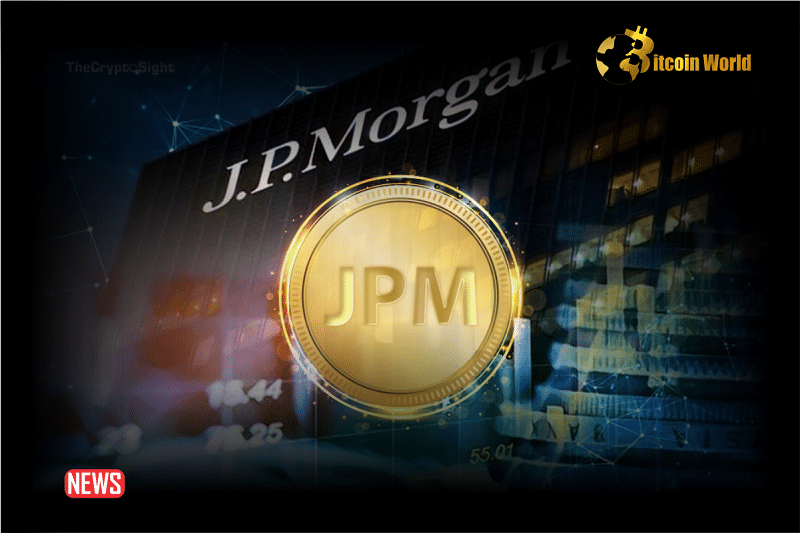Ever imagined a world where financial transactions are lightning-fast, secure, and almost… programmable? Well, JPMorgan Chase, a financial titan, is making strides to turn this vision into reality. Their blockchain-based digital currency, JPM Coin, is gearing up for a massive expansion, potentially handling a staggering $10 billion in transactions every single day within the next couple of years! Let’s dive into what this means for the future of finance and why it’s more than just another crypto headline.
JPM Coin’s Big Leap: What’s the Buzz?
JPMorgan isn’t just dipping its toes into blockchain; they’re diving in headfirst. Umar Farooq, JPMorgan’s Global Head of Financial Institution Payments, recently unveiled their ambitious plan to ramp up JPM Coin’s usage. Currently processing around $1 billion daily, the goal is to multiply this volume five to tenfold! This bold projection was shared at the Singapore FinTech Festival, signaling a significant commitment to blockchain technology in mainstream banking.
- Current Daily Transactions: $1 billion (approx.)
- Target Daily Transactions (1-2 years): Up to $10 billion
- Growth Projection: 5x to 10x increase
While JPMorgan handles trillions in traditional USD transactions daily, this expansion of JPM Coin is a clear indicator of their belief in blockchain’s potential to revolutionize payments. But what exactly is JPM Coin, and why is this expansion so noteworthy?
Understanding JPM Coin: A Quick Overview
JPM Coin isn’t your typical cryptocurrency. It’s a digital token created by JPMorgan for its wholesale clients. Think of it as a digital representation of fiat currency (like US dollars or Euros) operating on a private blockchain network. This means it’s not publicly traded like Bitcoin or Ethereum; it’s designed for institutional use within JPMorgan’s ecosystem.
Here’s a breakdown:
- Type: Digital token, not a cryptocurrency in the public sense.
- Currency Backing: Backed 1:1 by fiat currencies (USD, Euro).
- Network: Operates on a private blockchain (Onyx by JPMorgan).
- Users: JPMorgan’s wholesale clients (corporations, financial institutions).
- Purpose: Faster, more efficient, and potentially cheaper payments for large-scale transactions.
Blockchain enthusiasts often tout its ability to enable near-instantaneous payments at reduced costs compared to traditional systems. However, achieving scalability to match conventional payment networks has been an ongoing challenge. JPMorgan’s JPM Coin expansion is a real-world test of blockchain’s scalability in a major financial institution.
Programmable Payments: The Game Changer
Beyond just increasing transaction volume, JPMorgan is also enhancing JPM Coin with cutting-edge features. They’ve introduced programmable payments within their Onyx blockchain platform. What does this mean?
Imagine payments that can execute themselves based on pre-set conditions. This is the power of programmable payments. Instead of manual intervention, the system can automatically handle financial obligations. Think of it like smart contracts, but specifically for payments within the JPM Coin ecosystem.
Naveen Mallela, Onyx’s global head of coin systems, highlighted a practical example. Siemens, a global conglomerate, is already using JPM Coin and its programmable features to streamline their financial operations. They can program their accounts to automatically manage fund transfers based on specific triggers, like overdue payments or margin calls. This automation can significantly reduce manual work, minimize errors, and improve efficiency.
Read Also: JPMorgan launches BlackRock, a tokenization platform, among important clients: Examine
This programmability is a major leap forward. It paves the way for:
- Automated Treasury Operations: Streamlining complex financial processes.
- Real-time Settlements: Faster and more efficient transaction finality.
- Event-Driven Finance: Payments triggered by specific events, enhancing agility.
Why This Matters: Implications for the Future of Banking
JPMorgan’s aggressive push with JPM Coin is more than just internal optimization. It’s a strong signal to the entire financial industry. It demonstrates a growing acceptance and integration of blockchain technology at the highest levels of traditional finance.
Here’s why this expansion is significant:
- Mainstream Adoption of Blockchain: A major bank like JPMorgan scaling blockchain usage lends credibility to the technology.
- Setting a Precedent: Encourages other financial institutions to explore and adopt similar solutions.
- Potential for Industry Transformation: Blockchain’s promise of faster, cheaper, and more secure transactions could reshape banking as we know it.
- Driving Innovation: The success of JPM Coin can spur further development and adoption of digital currencies and blockchain across various sectors.
Could JPM Coin’s success accelerate the wider adoption of digital currencies and blockchain? It’s highly likely. As traditional banks like JPMorgan embrace these technologies, they unlock new possibilities for financial transactions, potentially redefining how businesses and individuals manage their finances globally.
In Conclusion: JPM Coin Leading the Charge
JPMorgan’s ambitious expansion of JPM Coin is a clear signpost pointing towards the increasing importance of blockchain in the financial world. As they push the boundaries of what’s possible with digital currencies and programmable payments, they are not just enhancing their own operations but also shaping the future trajectory of banking and the broader financial landscape. Keep an eye on JPM Coin – it’s likely to be a key player in the evolution of money and payments in the years to come.
Disclaimer: The information provided is not trading advice, Bitcoinworld.co.in holds no liability for any investments made based on the information provided on this page. We strongly recommend independent research and/or consultation with a qualified professional before making any investment decisions.


